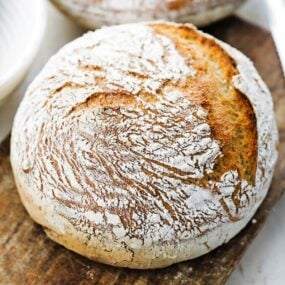

Kamut Flour Bread Recipe
This crusty Kamut Flour Bread loaf Recipe is light and flavorful and stays fresher longer using an Italian biga and three types of flour.
Ingredients
- 650 grams bread flour
- 250 grams kamut flour
- 150 grams Ivory wheat flour
- 880 grams water
- 25 grams coarse salt
- 4.5 grams active yeast
Instructions
- In a large container, mix together 550 grams of bread flour with 396 grams of water at 80° to 82° and .5 grams of yeast until combined. Cover and let sit at room temperature for 10 to 24 hours or until tripled in size.
- In a separate large container, mix together the remaining 150 grams of bread flour, Kamut, ivory wheat flour, salt, remaining 4 grams of yeast, and remaining 484 grams of water at 100 to 102° until combined.
- Add the biga to the mixture and vigorously mix it by squeezing, stretching, and folding until thoroughly mixed in, about 3 to 4 minutes. Cover and let rest for 20 minutes.
- Fold the dough by stretching and turning it 6 to 8 times every 20 minutes for 80 minutes.
- Cover and let rest for 2 more hours or until tripled in size.
- Divide the dough on a clean surface dusted with flour and form 2 taught dough balls. Transfer each to a floured proofing basket, cover with a towel, and let proof for 60 to 90 minutes.
- Place 2 Dutch oven pots into an oven preheated to 500° and let them sit for 30 minutes.
- Remove the pots and place the dough carefully into each Dutch oven. Score it with a bread knife or blade, cover, and bake for 30 minutes, then uncover and bake for another 20 to 25 minutes or until the outside of the bread is dark brown.
- Set on a cooling rack for 30 minutes.
- Slice and serve.
Notes
Make-Ahead: If you need to keep the bread warm before serving, wrap the loaf in aluminum foil and place it in a preheated 200°F oven for up to 30 minutes.
How to Store: Wrap the loaf in a clean kitchen towel or a bread bag and keep it on the kitchen counter for up to 2 days. You can also keep it covered and in the refrigerator for up to 10 days. Freeze it for up to 2 months. The higher acidity levels in the bread help extend its shelf life, so it lasts longer than regular bread.
Measure the ingredients with a kitchen scale for the most accurate measurements and results.
If you don’t have a kitchen scale, use the scoop and level method to measure the flour. By spooning the flour into the measuring cup and scraping the excess off the top, you avoid adding extra flour to the dough and maintain the proper hydration ratio.
Sift each flour separately to remove any lumps and to help aerate it before mixing.
Time and temperature can make or break this kamut flour bread recipe. It’s very important that your dough rises in a warm place (like a preheated and turned-off oven) and that you check the temperature of your dough after kneading to ensure optimal fermentation.
Always bake the bread in a preheated Dutch oven to help it rise faster (known as oven spring) and achieve a beautiful, crispy crust.
Baking the bread uncovered during the last 20 to 25 minutes triggers the Maillard reaction. This is where the proteins and sugars in the dough caramelize to create a flavorful browned crust.
Nutrition
Serving: 1sliceCalories: 244kcalCarbohydrates: 48gProtein: 8gFat: 1gSaturated Fat: 0.1gPolyunsaturated Fat: 0.3gMonounsaturated Fat: 0.1gSodium: 610mgPotassium: 53mgFiber: 3gSugar: 0.2gVitamin A: 1IUVitamin C: 0.001mgCalcium: 10mgIron: 2mg